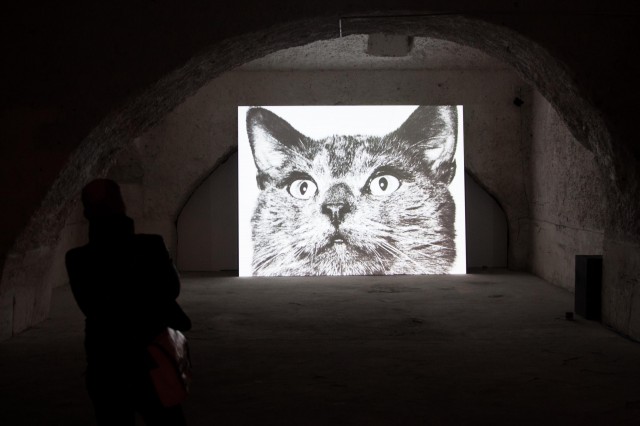Featuring new solo projects by Bettina Allamoda (Berlin) and Geoffrey Farmer (Vancouver), Fondazione Donnaregina per le arti contemporanee and Fondazione Morra Greco are proud to present the fourth and final installment of a series of exhibitions entitled Hybrid Naples: L’ordine delle idee deve procedere secondo l’ordine delle cose, part of the Progetto XXI exhibition project.
Bettina Allamoda
Bettina Allamoda‘s work takes methodological approaches first developed in the 1960s – not least by Arte Povera artists – to new frontiers. These new frontiers are those of a radically changed technological and ideological landscape, in a multi-polar, post-Cold-War world, connected by digital communication – and disconnected by the widening gap between the rich and the poor. What are the strategies of the powerful to control that environment? What do the powerless do to survive? And what are the tactics of those who still try to enjoy life amidst the mess? Cinema movies, buildings, television sets, even objects like crowd barriers or stretch fabric for fitness clothing are symptomatically shaped by these developments. Allamoda makes collages, sculptures, and installations that conjoin these developments into hybrid, surreal constellations. In a Giovanni Anselmo piece such as Torsione (1968), physical energy is literally stored by wringing a piece of leather on top of a concrete cube around its axis with a wooden bar that is eventually jammed against the wall; in an Allamoda piece like Bed Bondage Sculpture #3 (2010), a piece of black and velvet synthetic leather is wrung around what looks like a bar stool (but is a sculptor’s modeling stand), fixing it against the wall like a leaping Batman, thus “storing” physical as well as ideological energy – all of which she did amidst an exhibition (at September gallery in Berlin) dealing with the military-industrial complex and fantasies of invincibility and being obsessed in the wake of the Iraq War.
For her multi-part project especially conceived for the spaces of Fondazione Morra Greco, Allamoda is working with materials and images partly sourced in Naples: barrier or plexiglass objects are entangled in complex balances and imbalances by way of fabrics and plastic foils stretched or wrung around them, forming precarious sculptures, reminscent of 1970s TV studio dreams as much as futurist dystopican nightmares – Gameshow meets Robocop. Physical experience is warped through media experience, and viceversa: this is what Allamoda transfers into the realm of sculpture and collage, formalizing it into an abstracted yet physically concrete, sensory-spatial experience.
Geoffrey Farmer
What moves you? In Geoffrey Farmer‘s work that question is central in more than one sense: objects literally, kinetically, made to move; images that stir something in you that you might not haven even known is there; sounds that strike a chord and draw you in. This elastic relationship between object, image, and sound – fluctuating between the uncanny and the comical, the sentimental and the bizarre – is exemplified most vividly by Farmer’s recent project Let’s Make the Water Turn Black (2013), a multi-part installation-as-choreography that involves more than 70 sculptural elements (including a stone lion head split in half, glowing from inside; a Cactus with legs and penis; or a trimmed hedge waving with a feather) that are set to move, or be lit, in correspondence to an intricate and computer-controlled score of light and sound summoned to retell the story of Frank Zappa’s life. Farmer’s work is an aleatoric genealogy of American counter- culture, isolating rather than illustrating the timbres and feels of this tradition through the lens of the Zappaesque: with its roots in 1930s Musichall grotesque;1940s rural, hard-bitten folk and blues; 1950s black urban music; and the 1960s psychedelic cracking-open of heads.
For Naples, Farmer has further developed an ongoing project that has become a work titled The Process (2013). Here the approach is somewhat similar, albeit transferred to the medium of film. A projected collage of photographs – some of which were sourced in Naples, from thriftstore books and magazines – unfolds, accompanied by a soundtrack of noises, claps, timbres, patter of hooves, footsteps on gravel, in short: the kinds of sounds you might find in an audio stock library for film or radio. As the film unfolds, one notices that the images seem to be sown together not by a narrative, but the kind of algorithmic relationship one is accustomed with on the Web: i.e. “tags”, say “people walking”, or “weapons”, or both. Or animals, or “cute”, or “ruin”, or “mountains”. However these “tags” are not given away, we have to guess them, while the sounds blend them into an – illusory – whole. Reminiscent of the 1960s collage short films of Canadian avant-garde director Arthur Lipsett, the work unfolds a panorama of our collective sentiments, desires and fears, a kind of vivid phantom memory. At Fondazione Morra Greco, the work is complemented by further sculptural and audio elements.
The eight new solo projects of Hybrid Naples, exhibited in four stages, though conceived as singular statements, should form lose resonances and some tighter connections. Thus the aim of the project itself is hybrid in character: neither solo exhibitions nor group show, neither “prescriptive” themed curatorial endeavor nor “random” succession of individual projects, Hybrid Naples seeks to offer a different model for how art can take place and make sense without having to be illustrative.
(Text by Anna Cuomo)
